Career Development Plan and File Management Report - Law
VerifiedAdded on 2020/05/04
|7
|1559
|210
Report
AI Summary
This report outlines a law graduate's career development plan, focusing on skill improvement, departmental needs assessment, relationship building, work ethics, and commitment to company values. The plan includes steps for enhancing skills in report preparation, technical proficiency, and professional communication. It emphasizes aligning career goals with organizational achievements and developing effective file management systems for new client matters. The report details essential requirements for file management, including opening and maintaining active client files, preservation of client property, and adherence to ethical guidelines. It also incorporates a flowchart illustrating a comprehensive system for maintaining client matters, referencing relevant legal and business law publications to support the strategies.
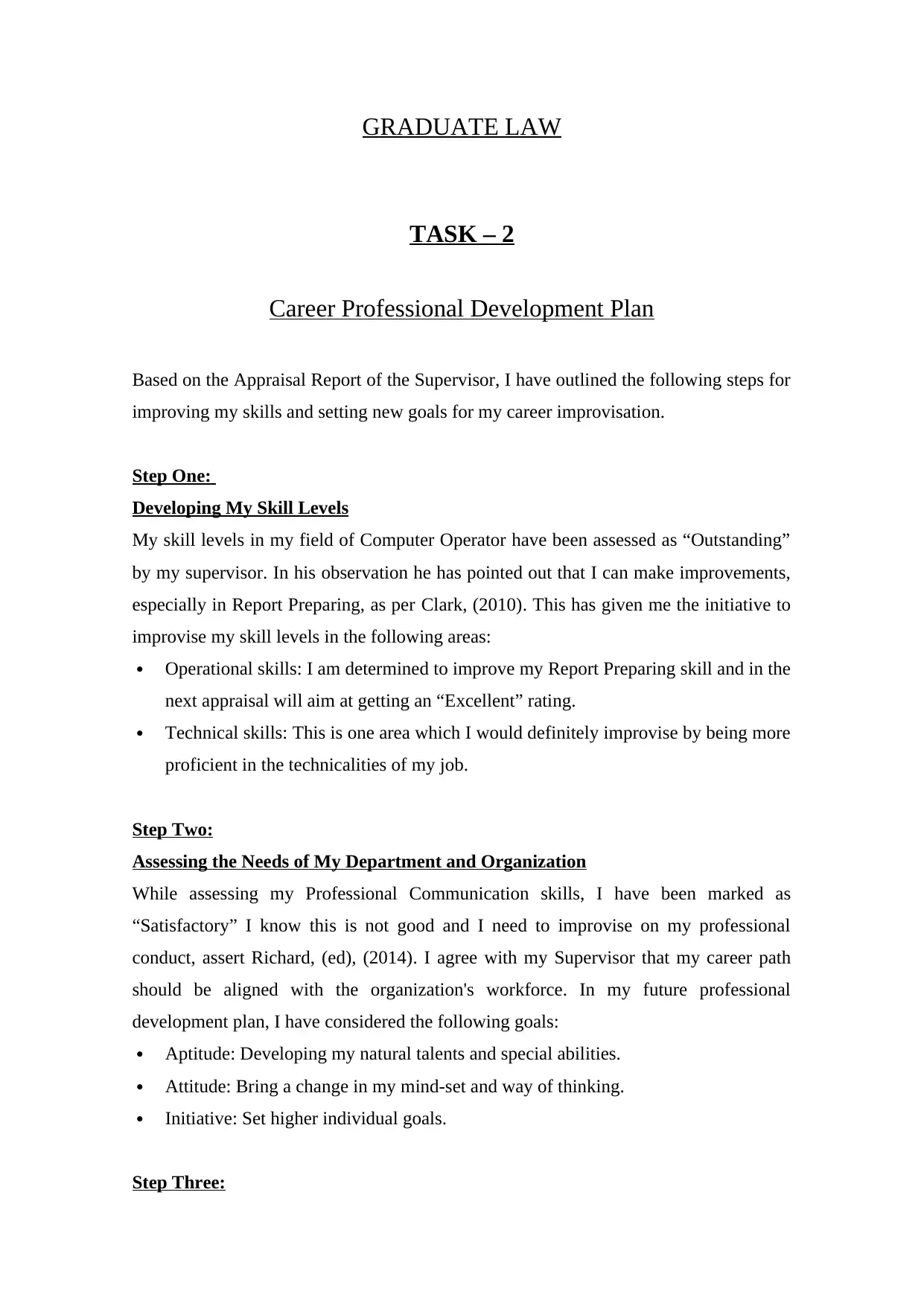
GRADUATE LAW
TASK – 2
Career Professional Development Plan
Based on the Appraisal Report of the Supervisor, I have outlined the following steps for
improving my skills and setting new goals for my career improvisation.
Step One:
Developing My Skill Levels
My skill levels in my field of Computer Operator have been assessed as “Outstanding”
by my supervisor. In his observation he has pointed out that I can make improvements,
especially in Report Preparing, as per Clark, (2010). This has given me the initiative to
improvise my skill levels in the following areas:
Operational skills: I am determined to improve my Report Preparing skill and in the
next appraisal will aim at getting an “Excellent” rating.
Technical skills: This is one area which I would definitely improvise by being more
proficient in the technicalities of my job.
Step Two:
Assessing the Needs of My Department and Organization
While assessing my Professional Communication skills, I have been marked as
“Satisfactory” I know this is not good and I need to improvise on my professional
conduct, assert Richard, (ed), (2014). I agree with my Supervisor that my career path
should be aligned with the organization's workforce. In my future professional
development plan, I have considered the following goals:
Aptitude: Developing my natural talents and special abilities.
Attitude: Bring a change in my mind-set and way of thinking.
Initiative: Set higher individual goals.
Step Three:
TASK – 2
Career Professional Development Plan
Based on the Appraisal Report of the Supervisor, I have outlined the following steps for
improving my skills and setting new goals for my career improvisation.
Step One:
Developing My Skill Levels
My skill levels in my field of Computer Operator have been assessed as “Outstanding”
by my supervisor. In his observation he has pointed out that I can make improvements,
especially in Report Preparing, as per Clark, (2010). This has given me the initiative to
improvise my skill levels in the following areas:
Operational skills: I am determined to improve my Report Preparing skill and in the
next appraisal will aim at getting an “Excellent” rating.
Technical skills: This is one area which I would definitely improvise by being more
proficient in the technicalities of my job.
Step Two:
Assessing the Needs of My Department and Organization
While assessing my Professional Communication skills, I have been marked as
“Satisfactory” I know this is not good and I need to improvise on my professional
conduct, assert Richard, (ed), (2014). I agree with my Supervisor that my career path
should be aligned with the organization's workforce. In my future professional
development plan, I have considered the following goals:
Aptitude: Developing my natural talents and special abilities.
Attitude: Bring a change in my mind-set and way of thinking.
Initiative: Set higher individual goals.
Step Three:
Paraphrase This Document
Need a fresh take? Get an instant paraphrase of this document with our AI Paraphraser
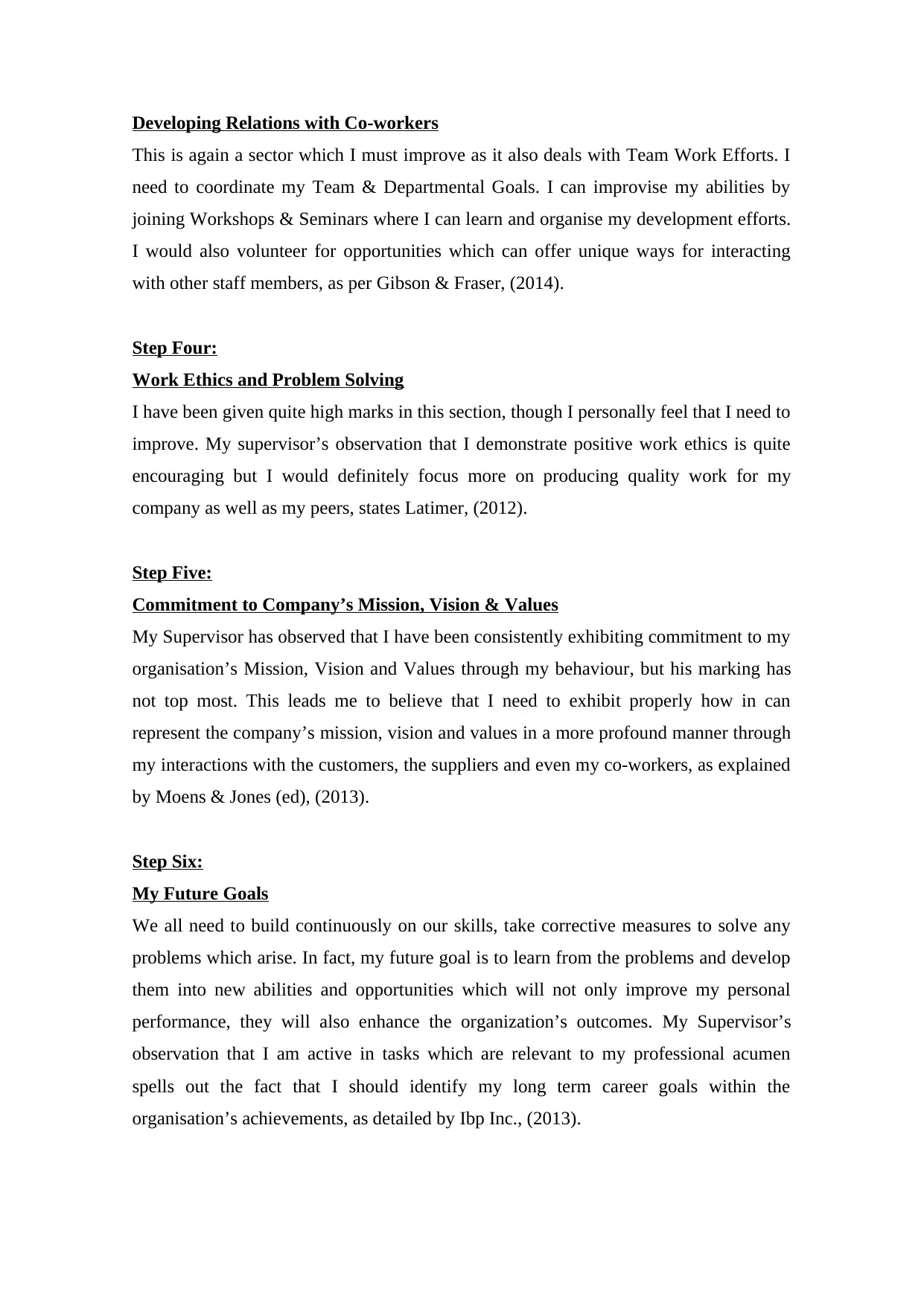
Developing Relations with Co-workers
This is again a sector which I must improve as it also deals with Team Work Efforts. I
need to coordinate my Team & Departmental Goals. I can improvise my abilities by
joining Workshops & Seminars where I can learn and organise my development efforts.
I would also volunteer for opportunities which can offer unique ways for interacting
with other staff members, as per Gibson & Fraser, (2014).
Step Four:
Work Ethics and Problem Solving
I have been given quite high marks in this section, though I personally feel that I need to
improve. My supervisor’s observation that I demonstrate positive work ethics is quite
encouraging but I would definitely focus more on producing quality work for my
company as well as my peers, states Latimer, (2012).
Step Five:
Commitment to Company’s Mission, Vision & Values
My Supervisor has observed that I have been consistently exhibiting commitment to my
organisation’s Mission, Vision and Values through my behaviour, but his marking has
not top most. This leads me to believe that I need to exhibit properly how in can
represent the company’s mission, vision and values in a more profound manner through
my interactions with the customers, the suppliers and even my co-workers, as explained
by Moens & Jones (ed), (2013).
Step Six:
My Future Goals
We all need to build continuously on our skills, take corrective measures to solve any
problems which arise. In fact, my future goal is to learn from the problems and develop
them into new abilities and opportunities which will not only improve my personal
performance, they will also enhance the organization’s outcomes. My Supervisor’s
observation that I am active in tasks which are relevant to my professional acumen
spells out the fact that I should identify my long term career goals within the
organisation’s achievements, as detailed by Ibp Inc., (2013).
This is again a sector which I must improve as it also deals with Team Work Efforts. I
need to coordinate my Team & Departmental Goals. I can improvise my abilities by
joining Workshops & Seminars where I can learn and organise my development efforts.
I would also volunteer for opportunities which can offer unique ways for interacting
with other staff members, as per Gibson & Fraser, (2014).
Step Four:
Work Ethics and Problem Solving
I have been given quite high marks in this section, though I personally feel that I need to
improve. My supervisor’s observation that I demonstrate positive work ethics is quite
encouraging but I would definitely focus more on producing quality work for my
company as well as my peers, states Latimer, (2012).
Step Five:
Commitment to Company’s Mission, Vision & Values
My Supervisor has observed that I have been consistently exhibiting commitment to my
organisation’s Mission, Vision and Values through my behaviour, but his marking has
not top most. This leads me to believe that I need to exhibit properly how in can
represent the company’s mission, vision and values in a more profound manner through
my interactions with the customers, the suppliers and even my co-workers, as explained
by Moens & Jones (ed), (2013).
Step Six:
My Future Goals
We all need to build continuously on our skills, take corrective measures to solve any
problems which arise. In fact, my future goal is to learn from the problems and develop
them into new abilities and opportunities which will not only improve my personal
performance, they will also enhance the organization’s outcomes. My Supervisor’s
observation that I am active in tasks which are relevant to my professional acumen
spells out the fact that I should identify my long term career goals within the
organisation’s achievements, as detailed by Ibp Inc., (2013).
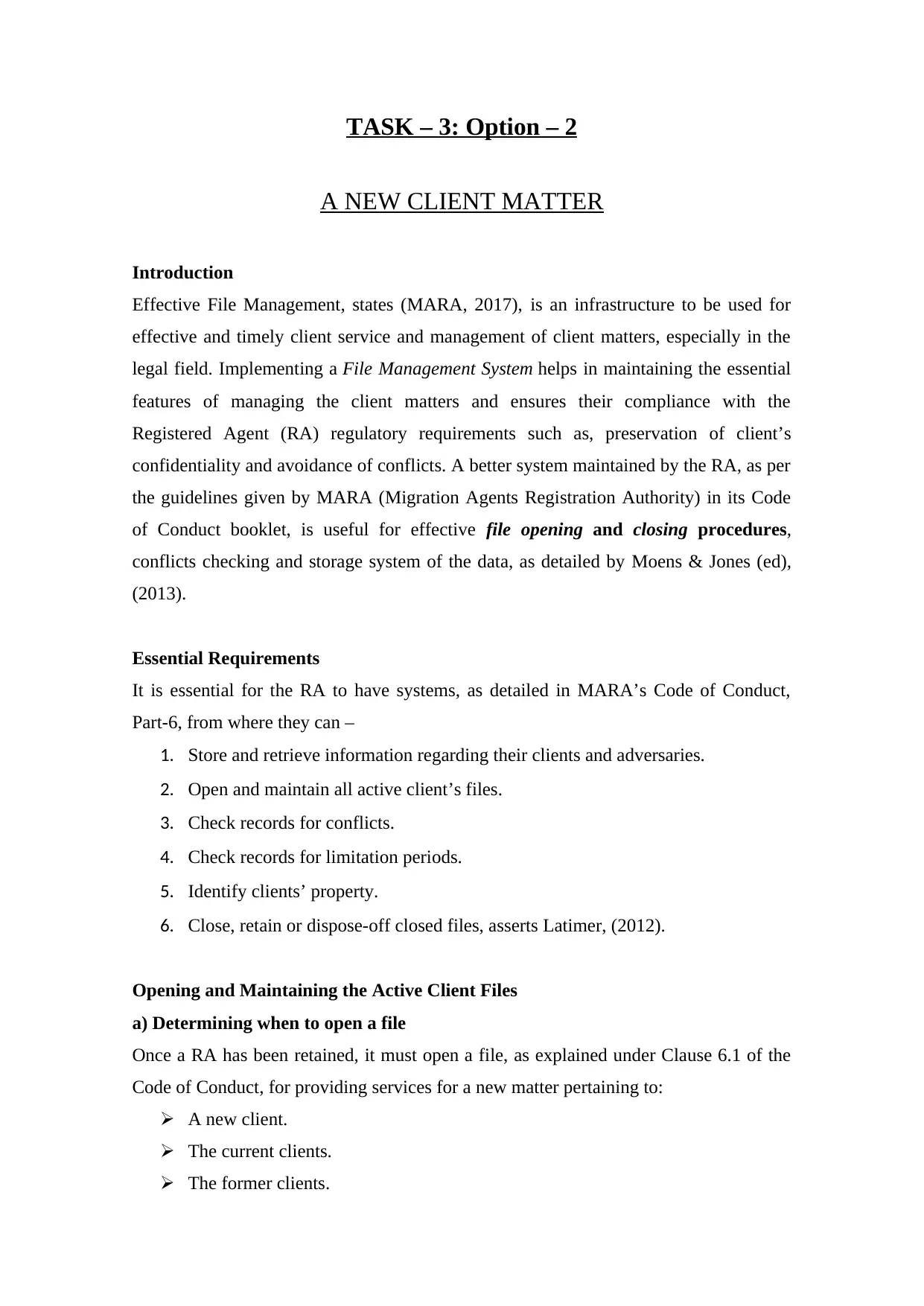
TASK – 3: Option – 2
A NEW CLIENT MATTER
Introduction
Effective File Management, states (MARA, 2017), is an infrastructure to be used for
effective and timely client service and management of client matters, especially in the
legal field. Implementing a File Management System helps in maintaining the essential
features of managing the client matters and ensures their compliance with the
Registered Agent (RA) regulatory requirements such as, preservation of client’s
confidentiality and avoidance of conflicts. A better system maintained by the RA, as per
the guidelines given by MARA (Migration Agents Registration Authority) in its Code
of Conduct booklet, is useful for effective file opening and closing procedures,
conflicts checking and storage system of the data, as detailed by Moens & Jones (ed),
(2013).
Essential Requirements
It is essential for the RA to have systems, as detailed in MARA’s Code of Conduct,
Part-6, from where they can –
1. Store and retrieve information regarding their clients and adversaries.
2. Open and maintain all active client’s files.
3. Check records for conflicts.
4. Check records for limitation periods.
5. Identify clients’ property.
6. Close, retain or dispose-off closed files, asserts Latimer, (2012).
Opening and Maintaining the Active Client Files
a) Determining when to open a file
Once a RA has been retained, it must open a file, as explained under Clause 6.1 of the
Code of Conduct, for providing services for a new matter pertaining to:
A new client.
The current clients.
The former clients.
A NEW CLIENT MATTER
Introduction
Effective File Management, states (MARA, 2017), is an infrastructure to be used for
effective and timely client service and management of client matters, especially in the
legal field. Implementing a File Management System helps in maintaining the essential
features of managing the client matters and ensures their compliance with the
Registered Agent (RA) regulatory requirements such as, preservation of client’s
confidentiality and avoidance of conflicts. A better system maintained by the RA, as per
the guidelines given by MARA (Migration Agents Registration Authority) in its Code
of Conduct booklet, is useful for effective file opening and closing procedures,
conflicts checking and storage system of the data, as detailed by Moens & Jones (ed),
(2013).
Essential Requirements
It is essential for the RA to have systems, as detailed in MARA’s Code of Conduct,
Part-6, from where they can –
1. Store and retrieve information regarding their clients and adversaries.
2. Open and maintain all active client’s files.
3. Check records for conflicts.
4. Check records for limitation periods.
5. Identify clients’ property.
6. Close, retain or dispose-off closed files, asserts Latimer, (2012).
Opening and Maintaining the Active Client Files
a) Determining when to open a file
Once a RA has been retained, it must open a file, as explained under Clause 6.1 of the
Code of Conduct, for providing services for a new matter pertaining to:
A new client.
The current clients.
The former clients.
⊘ This is a preview!⊘
Do you want full access?
Subscribe today to unlock all pages.

Trusted by 1+ million students worldwide
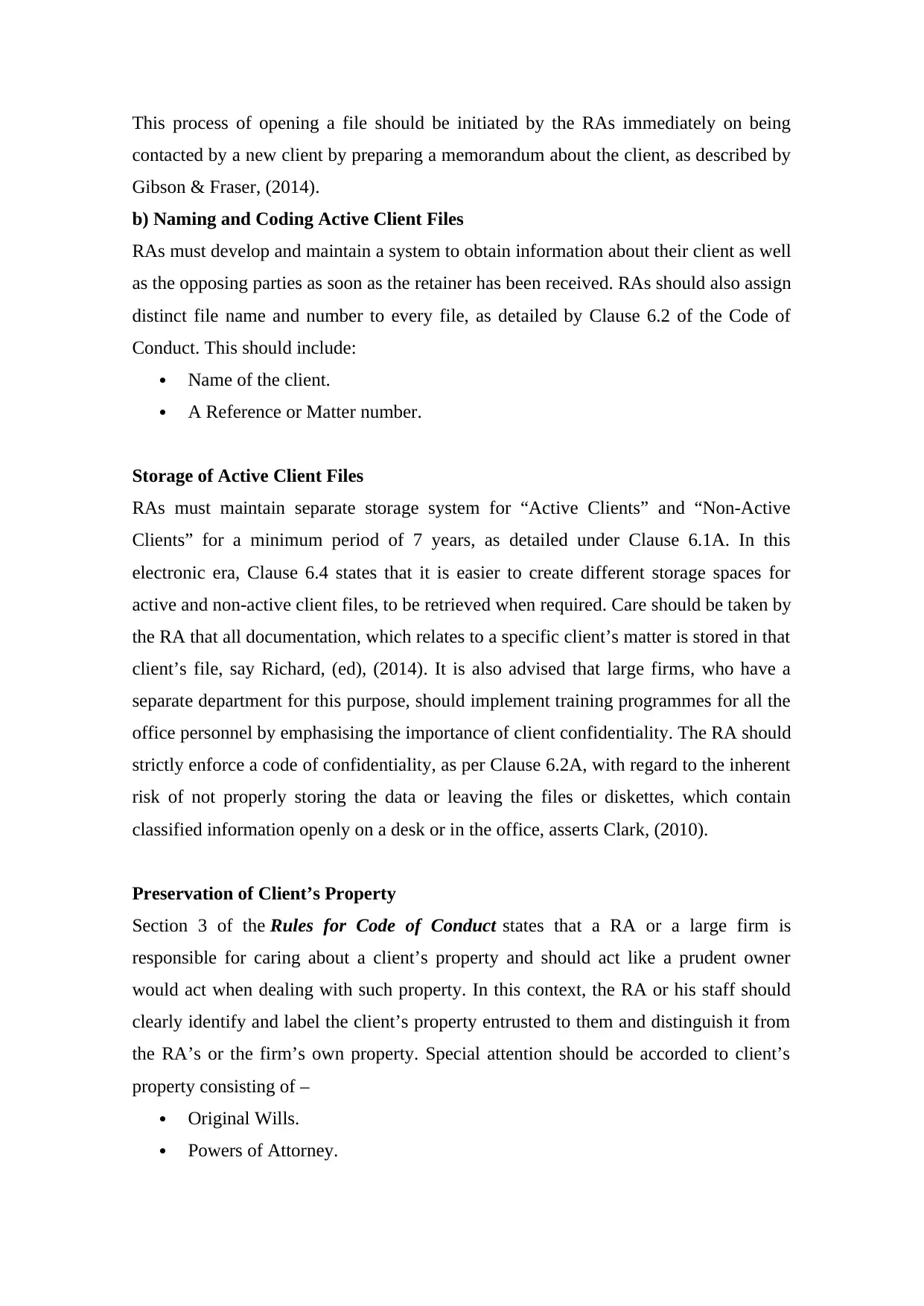
This process of opening a file should be initiated by the RAs immediately on being
contacted by a new client by preparing a memorandum about the client, as described by
Gibson & Fraser, (2014).
b) Naming and Coding Active Client Files
RAs must develop and maintain a system to obtain information about their client as well
as the opposing parties as soon as the retainer has been received. RAs should also assign
distinct file name and number to every file, as detailed by Clause 6.2 of the Code of
Conduct. This should include:
Name of the client.
A Reference or Matter number.
Storage of Active Client Files
RAs must maintain separate storage system for “Active Clients” and “Non-Active
Clients” for a minimum period of 7 years, as detailed under Clause 6.1A. In this
electronic era, Clause 6.4 states that it is easier to create different storage spaces for
active and non-active client files, to be retrieved when required. Care should be taken by
the RA that all documentation, which relates to a specific client’s matter is stored in that
client’s file, say Richard, (ed), (2014). It is also advised that large firms, who have a
separate department for this purpose, should implement training programmes for all the
office personnel by emphasising the importance of client confidentiality. The RA should
strictly enforce a code of confidentiality, as per Clause 6.2A, with regard to the inherent
risk of not properly storing the data or leaving the files or diskettes, which contain
classified information openly on a desk or in the office, asserts Clark, (2010).
Preservation of Client’s Property
Section 3 of the Rules for Code of Conduct states that a RA or a large firm is
responsible for caring about a client’s property and should act like a prudent owner
would act when dealing with such property. In this context, the RA or his staff should
clearly identify and label the client’s property entrusted to them and distinguish it from
the RA’s or the firm’s own property. Special attention should be accorded to client’s
property consisting of –
Original Wills.
Powers of Attorney.
contacted by a new client by preparing a memorandum about the client, as described by
Gibson & Fraser, (2014).
b) Naming and Coding Active Client Files
RAs must develop and maintain a system to obtain information about their client as well
as the opposing parties as soon as the retainer has been received. RAs should also assign
distinct file name and number to every file, as detailed by Clause 6.2 of the Code of
Conduct. This should include:
Name of the client.
A Reference or Matter number.
Storage of Active Client Files
RAs must maintain separate storage system for “Active Clients” and “Non-Active
Clients” for a minimum period of 7 years, as detailed under Clause 6.1A. In this
electronic era, Clause 6.4 states that it is easier to create different storage spaces for
active and non-active client files, to be retrieved when required. Care should be taken by
the RA that all documentation, which relates to a specific client’s matter is stored in that
client’s file, say Richard, (ed), (2014). It is also advised that large firms, who have a
separate department for this purpose, should implement training programmes for all the
office personnel by emphasising the importance of client confidentiality. The RA should
strictly enforce a code of confidentiality, as per Clause 6.2A, with regard to the inherent
risk of not properly storing the data or leaving the files or diskettes, which contain
classified information openly on a desk or in the office, asserts Clark, (2010).
Preservation of Client’s Property
Section 3 of the Rules for Code of Conduct states that a RA or a large firm is
responsible for caring about a client’s property and should act like a prudent owner
would act when dealing with such property. In this context, the RA or his staff should
clearly identify and label the client’s property entrusted to them and distinguish it from
the RA’s or the firm’s own property. Special attention should be accorded to client’s
property consisting of –
Original Wills.
Powers of Attorney.
Paraphrase This Document
Need a fresh take? Get an instant paraphrase of this document with our AI Paraphraser
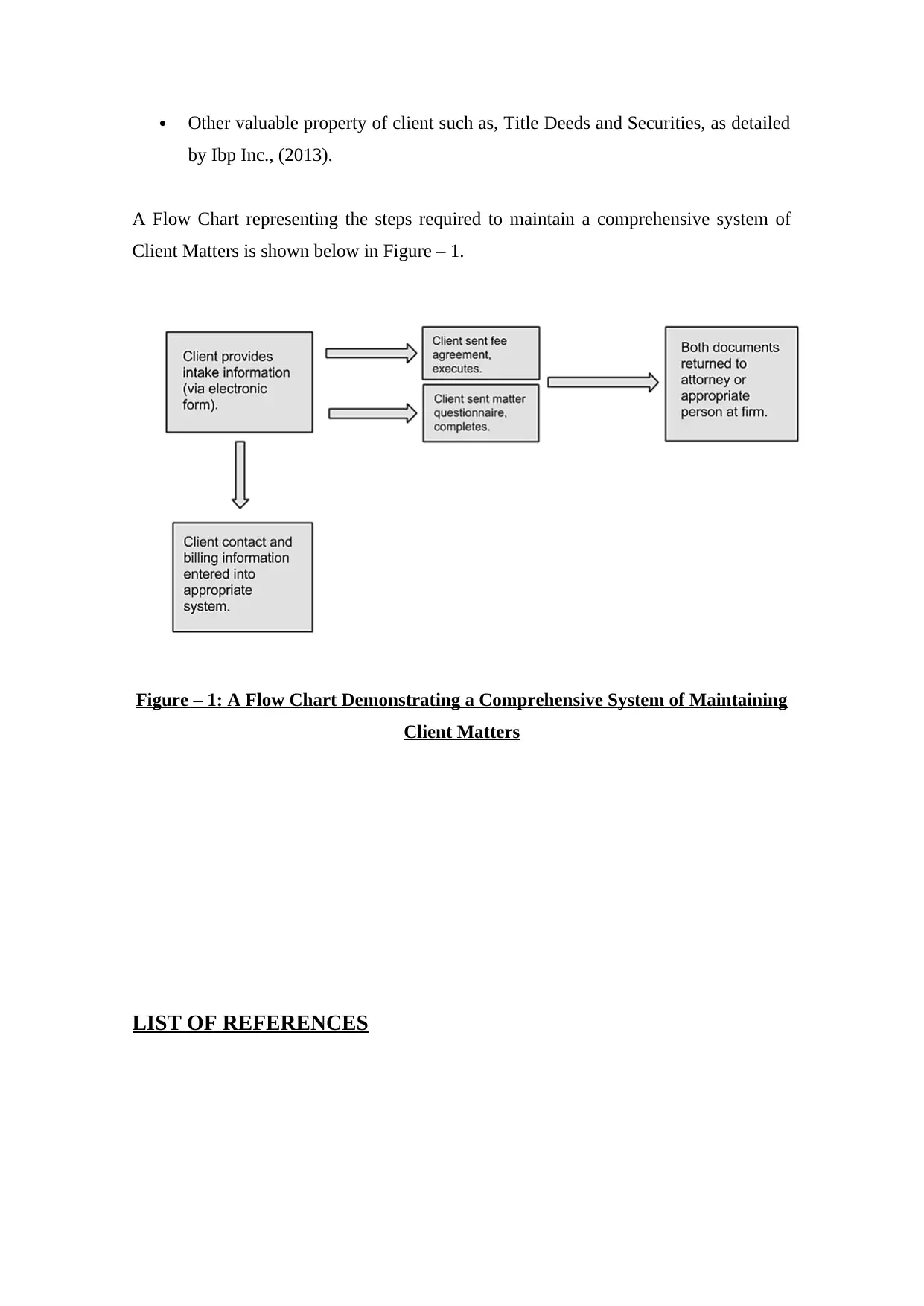
Other valuable property of client such as, Title Deeds and Securities, as detailed
by Ibp Inc., (2013).
A Flow Chart representing the steps required to maintain a comprehensive system of
Client Matters is shown below in Figure – 1.
Figure – 1: A Flow Chart Demonstrating a Comprehensive System of Maintaining
Client Matters
LIST OF REFERENCES
by Ibp Inc., (2013).
A Flow Chart representing the steps required to maintain a comprehensive system of
Client Matters is shown below in Figure – 1.
Figure – 1: A Flow Chart Demonstrating a Comprehensive System of Maintaining
Client Matters
LIST OF REFERENCES
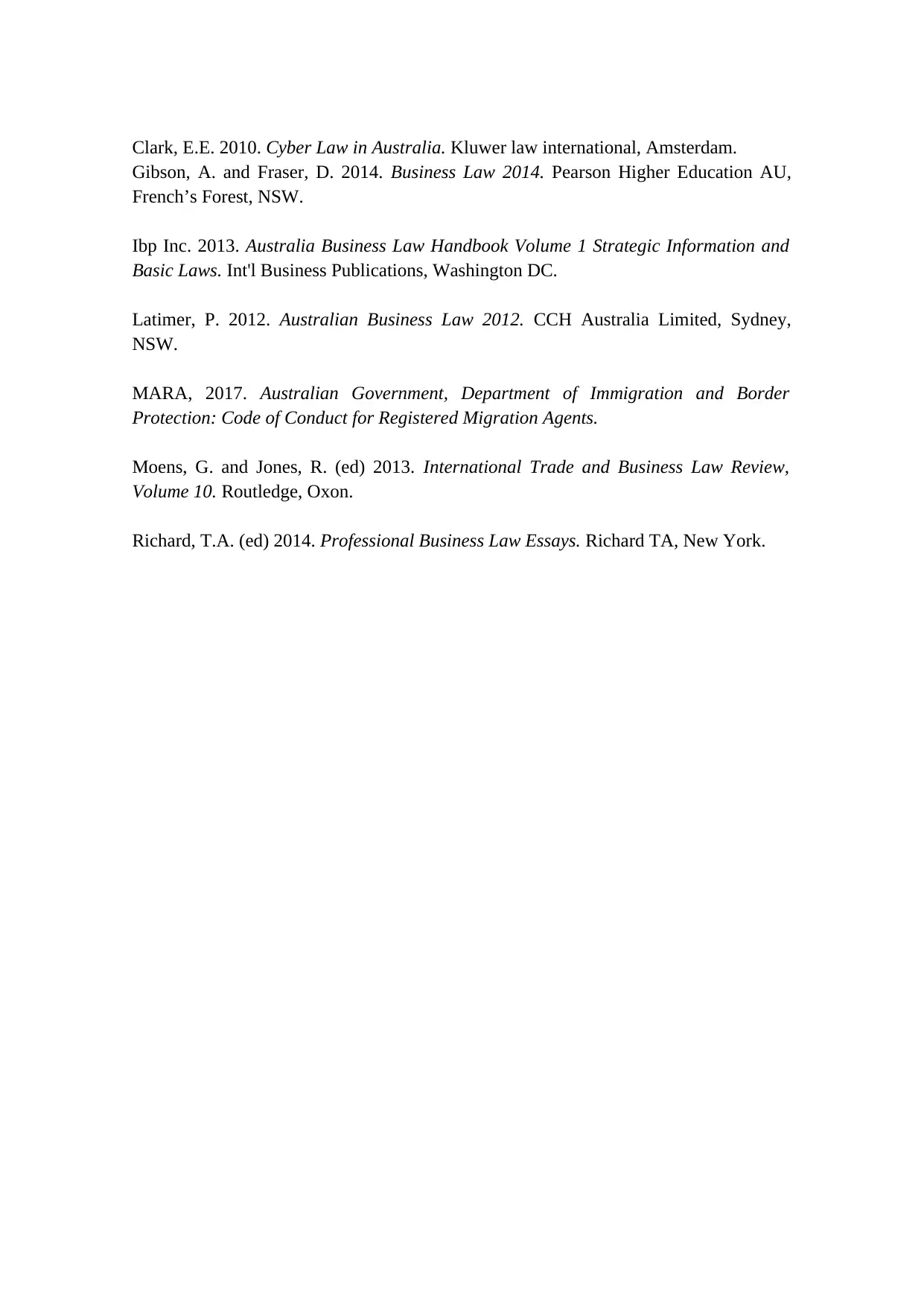
Clark, E.E. 2010. Cyber Law in Australia. Kluwer law international, Amsterdam.
Gibson, A. and Fraser, D. 2014. Business Law 2014. Pearson Higher Education AU,
French’s Forest, NSW.
Ibp Inc. 2013. Australia Business Law Handbook Volume 1 Strategic Information and
Basic Laws. Int'l Business Publications, Washington DC.
Latimer, P. 2012. Australian Business Law 2012. CCH Australia Limited, Sydney,
NSW.
MARA, 2017. Australian Government, Department of Immigration and Border
Protection: Code of Conduct for Registered Migration Agents.
Moens, G. and Jones, R. (ed) 2013. International Trade and Business Law Review,
Volume 10. Routledge, Oxon.
Richard, T.A. (ed) 2014. Professional Business Law Essays. Richard TA, New York.
Gibson, A. and Fraser, D. 2014. Business Law 2014. Pearson Higher Education AU,
French’s Forest, NSW.
Ibp Inc. 2013. Australia Business Law Handbook Volume 1 Strategic Information and
Basic Laws. Int'l Business Publications, Washington DC.
Latimer, P. 2012. Australian Business Law 2012. CCH Australia Limited, Sydney,
NSW.
MARA, 2017. Australian Government, Department of Immigration and Border
Protection: Code of Conduct for Registered Migration Agents.
Moens, G. and Jones, R. (ed) 2013. International Trade and Business Law Review,
Volume 10. Routledge, Oxon.
Richard, T.A. (ed) 2014. Professional Business Law Essays. Richard TA, New York.
⊘ This is a preview!⊘
Do you want full access?
Subscribe today to unlock all pages.

Trusted by 1+ million students worldwide

1 out of 7
Related Documents
Your All-in-One AI-Powered Toolkit for Academic Success.
+13062052269
info@desklib.com
Available 24*7 on WhatsApp / Email
![[object Object]](/_next/static/media/star-bottom.7253800d.svg)
Unlock your academic potential
Copyright © 2020–2025 A2Z Services. All Rights Reserved. Developed and managed by ZUCOL.





